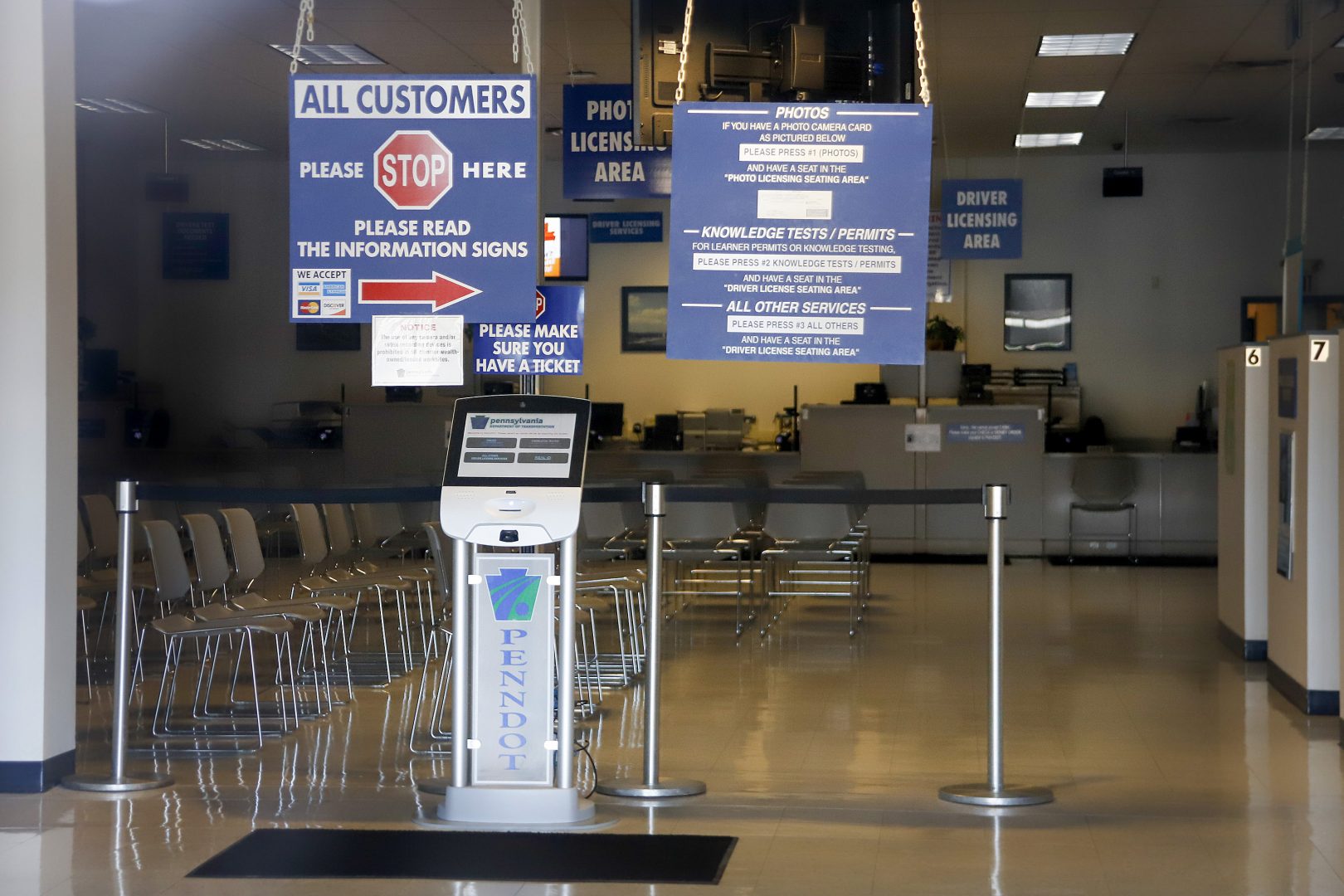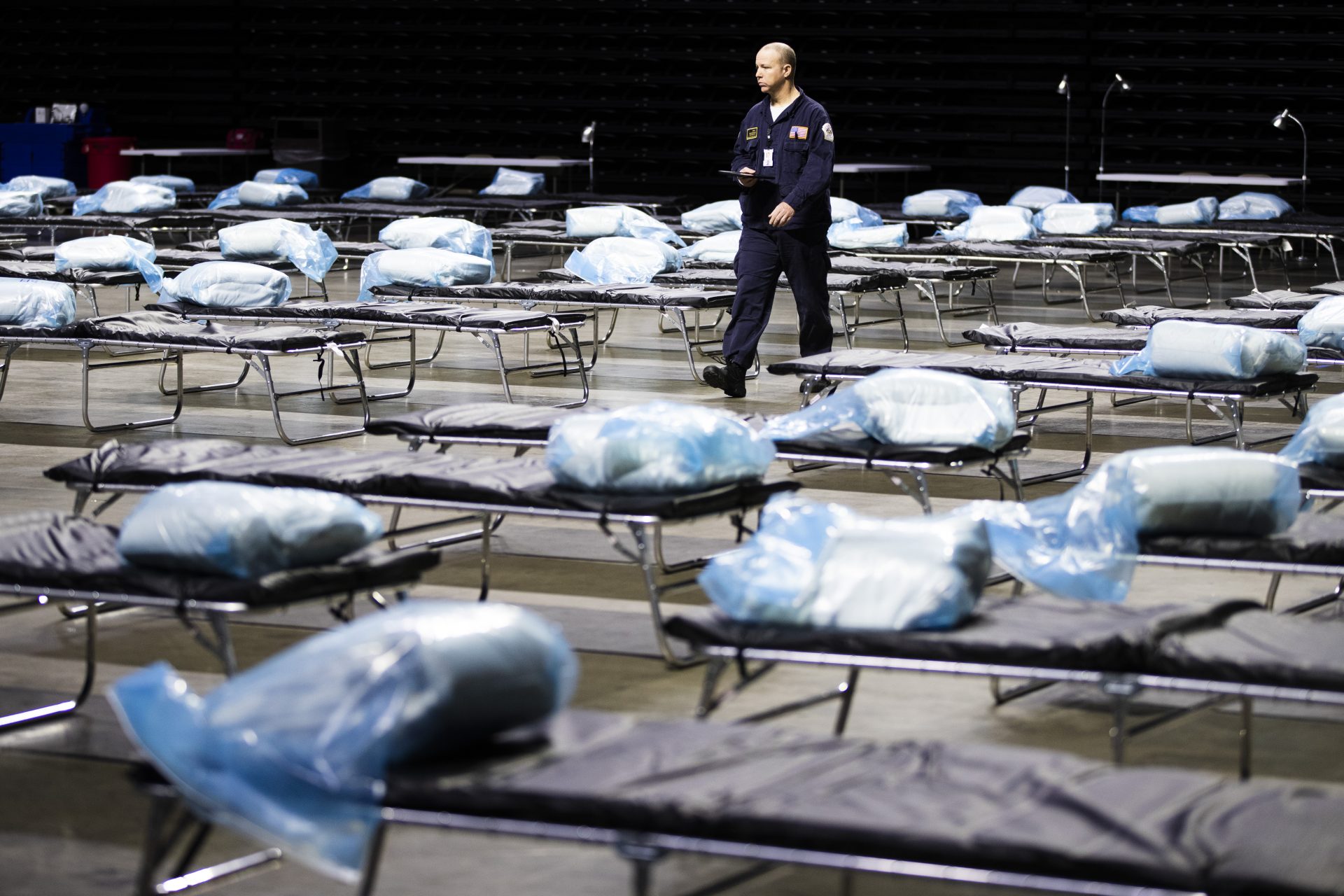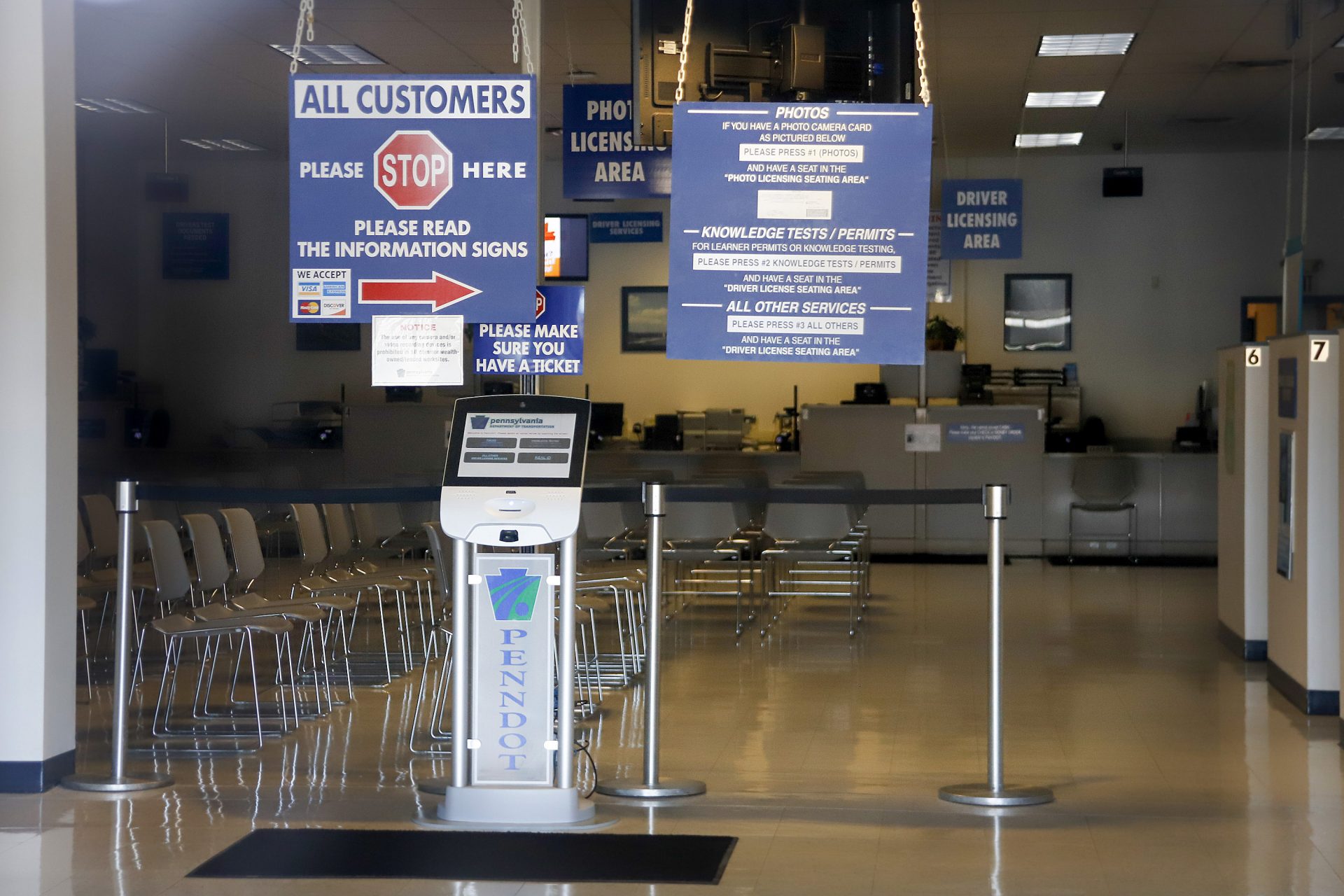
The seats and aisles are empty as seen through the window of the closed Penndot Drivers License Center in Butler, Pa., Friday, April 3, 2020.
Keith Srakocic / AP Photo

The seats and aisles are empty as seen through the window of the closed Penndot Drivers License Center in Butler, Pa., Friday, April 3, 2020.
Keith Srakocic / AP Photo

Keith Srakocic / AP Photo
The seats and aisles are empty as seen through the window of the closed Penndot Drivers License Center in Butler, Pa., Friday, April 3, 2020.
What you should know
» Coronavirus facts & FAQ
» Day-by-day look at coronavirus disease cases in Pa.
» What the governor’s stay-at-home order means
(Philadelphia) — U.S. Surgeon General Dr. Jerome Adams over the weekend told Americans to brace for a week that would define a generation — with projections showing that many thousands would soon die from the COVID-19 contagion.
“This is going to be our Pearl Harbor moment, our 9/11 moment, only it’s not going to be localized, it’s going to be happening all over the country,” he said.
But revised projections released Sunday by the University of Washington’s Institute for Health Metrics and Evaluation, the same projections used in recent White House briefings, show that states like Pennsylvania may be faring better than others –– nearing a peak of new infections with a projected surplus of hospital beds.
The IHME puts Pa. just five days away from peak hospital usage, with an estimated surplus of some 14,000 hospital beds.

Pennsylvania Task Force 1 member Greg Rogalski walks amongst the beds of a Federal Medical Station for hospital surge capacity set up at Temple University’s Liacouras Center in Philadelphia, Monday, March 30, 2020. (AP Photo/Matt Rourke)
Estimates put the state nine days away from a peak in daily deaths –– 32 deaths per day, by April 15th.
The state Department of Health reported 1,470 more coronavirus cases confirmed on Sunday, bringing the statewide total to 12,980 in 65 of 67 counties. The department also reported 12 more deaths, for a statewide total of 162. Three of those newly reported deaths were in Lancaster County, which has the highest death total in the midstate.
A total 1,483 cases and 20 deaths have been reported in central Pennsylvania counties: Adams (25); Berks (326, including 3 deaths); Columbia (26); Cumberland (68, including 2 deaths); Dauphin (132, including 1 death); Franklin (32); Juniata (11); Lancaster (408, including 11 deaths); Lebanon (124); Mifflin (5); Northumberland (15); Perry (5, including 1 death); Schuylkill (103); Snyder (8, including 1 death); Union (6) and York (189, including 1 death).
The initial models for the United States created by the IHME were based only on data out of Wuhan, China. Now that several more cities in Italy and Spain have reached their peak of hospital resources and deaths, the institute has more information on which to measure the relationship between social distancing measures and the virus’ impact.
The revised projections show lower estimates nationally for hospital bed use and cumulative deaths during the first wave of COVID-19 infections.
“It’s a surprisingly accurate model. Their predictions of what today would look like three weeks ago are very good,” said Dr. Mark Roberts, director of the Public Health Dynamics Lab at the University of Pittsburgh.
Although the IHME model found the worst days were still ahead, it puts the US about nine days away from the peak of COVID spread. Among other factors behind the more optimistic revision, the latest adjustments take into account the positive impacts of social distancing, according to the IHME.
Pennsylvania health officials are watching the IHME projections, among others, and were cautiously optimistic in response to Sunday’s adjustment.
“While we are hopeful that our social distancing and mitigation efforts have been successful, the model assumes full social distancing through May of 2020,” said Nate Wardle, spokesperson for the Pennsylvania Department of Health.
IHME estimates varied heavily from state to state. While Keystone State may be ahead of the curve, researchers still expect a shortage of some 36,000 beds nationally by peak hospitalization, according to the latest projections.
New Jersey death toll projected to rise
New Jersey is still on course for hospital shortages, its death rate revised upward.
The IHME put the Garden State nine days away from peak hospitalization, with an estimated shortage of some 16,887 beds –– nearly half of the beds needed nationally, in just a single state. Much of the remaining bed shortage is in New York state, which has similarly struggled to contain the spread of the virus.
Unlike many other parts of the U.S., New Jersey’s death total moved upwards, to a peak of nearly 600 deaths in a single day, according to the model.
“The reason for the increased peak daily deaths projections is increasingly more deaths being reported in New Jersey over the last few days,” IHME methodology reads.
Based on IHME’s model, New Jersey’s hospitals may have reached maximum capacity on April 2. While Pennsylvania is currently projected to weather the crisis with a surplus of hospital space, New Jersey would need to drastically increase the number of available beds by April 15.
However, an uneven distribution of cases throughout New Jersey, and hospitals’ diverting cases to ambulatory centers or other nontraditional areas for acute care, has helped delay this overload. And the IHME model does not totally account for state’s adding space.

Keith Srakocic / AP Photo
The seats and aisles are empty as seen through the window of the closed Penndot Drivers License Center in Butler, Pa., Friday, April 3, 2020. Pennsylvania will stop paying about 9,000 state workers whose offices have been closed as a result of the coronavirus pandemic, officials said Friday. The pay freeze affects about 12% of the state workforce, though individual agencies were hit much harder, with the state departments of Transportation and Revenue halting pay to more than half their employees.
New Jersey Health Commissioner Judith Persichilli said Monday that the state and health care providers have been working overtime to add tens of thousands of beds: creating field stations, reopening closed hospitals, converting hotels and receiving aid from federal agencies.
“Our hospitals have been working to double their critical care capacity,” she said. “We are aggressively working to open alternate care sites.”
Pennsylvania hospitals, too, have largely canceled elective surgeries and taken other steps to add beds for COVID-19 patients.
Wardle also said his department would assess Pennsylvania’s ability to absorb patients from other states if and when that time comes. He noted that some parts of the state may not have beds to spare.
“Even if we do see a surplus, that would be statewide and may not represent the ability for eastern Pa. hospitals to take on extra patients,” he wrote in an email.
There are more than 5,100 ventilators in the Pennsylvania hospital system, and 70% are available. Of the state’s 3,400 licensed ICU beds, 60% are currently in use.
Roberts, who had helped author a more pessimistic projection of COVID-19 spread in Pennsylvania last month, also expressed concern about elements of the IHMC methodology.
“In their model, they say they’re maintaining social distancing the whole time,” he said.
“If you maintain social distancing levels seen in China, that might work. But if you remove it and you don’t have herd immunity levels, the virus will come back.”
Assuming that the rampant spread of COVID-19 does begin to slow after a deadly peak, the physician said the future depends on the choices the states, and the nation as a whole, make in determining what to do next.
Roberts was personally skeptical that officials could resist the temptation to reboot a largely idled economy, especially in the face of numbers that indicate the infection is slowing.
“I don’t think we’ll be able to maintain the level of social distancing needed to maintain that,” he said. “I don’t think we have the resources or the will.”
WHYY is the leading public media station serving the Philadelphia region, including Delaware, South Jersey and Pennsylvania. This story originally appeared on WHYY.org.

A collection of interviews, photos, and music videos, featuring local musicians who have stopped by the WITF performance studio to share a little discussion and sound. Produced by WITF’s Joe Ulrich.
The days of journalism’s one-way street of simply producing stories for the public have long been over. Now, it’s time to find better ways to interact with you and ensure we meet your high standards of what a credible media organization should be.